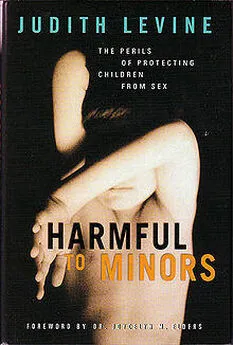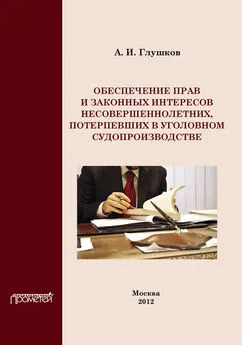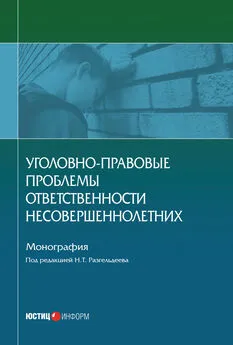Judith Levine - Вредно для несовершеннолетних
- Название:Вредно для несовершеннолетних
- Автор:
- Жанр:
- Издательство:неизвестно
- Год:неизвестен
- ISBN:нет данных
- Рейтинг:
- Избранное:Добавить в избранное
-
Отзывы:
-
Ваша оценка:
Judith Levine - Вредно для несовершеннолетних краткое содержание
Вредно для несовершеннолетних - читать онлайн бесплатно полную версию (весь текст целиком)
Интервал:
Закладка:
Что будет мешать ребенку, вступающему в эти потоки? Иерархии расы, гендера и красоты, заставляющие ее сомневаться в самой себе и презирать других, кто отличается. Экономические и социальные неравенства, закрывающие ее горизонты до того, как она становится достаточно высокой, чтобы заглянуть за них. Сексуальные стыд и невежество, ведущие к неудовлетворенности в лучшем случае, к катастрофе в худшем.
А что будет удерживать ребенка на плаву? Знание и гордость от своего тела, свобода для своих чувств, уважение взрослых к ее уму, воле и приватности. Хорошая пища и безопасная кухня, чтобы ее есть, зеленое пространство, библиотеки, наполненные книгами и компьютерами, семья и друзья, имеющие время и средства, чтобы ее любить и не обижать. Община, заботящаяся о своих более маленьких, более слабых членах не менее, чем она носится со своими агрессивными и успешными, прославляющая счастье не менее, чем она выискивает злобу.
Аллигаторы таятся на дне сна каждого ребенка. Опасность неизбежна в детстве, и самой худшей болью для взрослых может быть бессилие ее предотвратить. Однако, когда дети выходят в большой мир, защищать их от секса - не защитит их от тех опасностей, которые имеют мало отношения к сексу, но могут в конечном итоге делать секс опасным.
Секс не вреден для детей. Это средство к самопознанию, любви, исцелению, творчеству, приключениям и сильнейшим ощущениям того, что ты живой. Есть множество способов, которыми даже самые маленькие дети могут быть к нему причастны. Наш моральный долг перед следующим поколением - сделать мир таким, чтобы каждый ребенок мог быть причастен к нему безопасно, таким, в котором нужды и вожделения каждого ребенка - к свершению, соединению, значению и удовольствию - смогут быть замечательным образом удовлетворены.
Примечания и библиографические ссылки к "Вредно для несовершеннолетних"
Foreword
1. These statistics appear in The Surgeon General's Call to Action to Promote Sexual Health and Responsible Sexual Behavior , a publication of the U.S. Public Health Service and the Department of Health and Human Services (Rockville, Md.: DHEW Publications, 2001).
2. Recent reports by the Kaiser Family Foundation state that in interviews 98 percent of parents thought sex education should include information about sexually transmitted diseases; 97 percent thought it should talk about abstinence; 90 percent said birth control should be discussed; and 85 percent said it should teach kids how to use condoms. The following two reports of the Kaiser Family Foundation provide this information: "The AIDS Epidemic at 20 Years: The View from America," A National Survey of Americans and HIV/AIDS (June 2001), and "Sex Education in America: A Series of National Surveys of Students, Parents, Teachers, and Principals" (September 2000).
3. Ralph J. Di Clemente, "Preventing Sexually Transmitted Infections among Adolescents: A Clash of Ideology and Science (Editorial)," Journal of the American Medical Association 279, no. 19 (20 May 1998): 1574-75.
4. Ira L. Reiss and Harriet M. Reiss, Solving America's Sexual Crisis (Amherst: Prometheus Books, 1997). My two immediate predecessors as Surgeon General, Antonia Novello and C. Everett Koop, had called for sex education and advocated the use of condoms. The call to action of our present Surgeon General, Dr. David Satcher, would also appear to be supportive.
Introduction
1. Whereas the assets of the richest 20 percent of Americans can keep them afloat for about two years without a paycheck (at the same level of spending) most of the middle class are able to last just over two months. The poorest 20 percent can't make it a day. Doug Henwood, "Wealth Report," Nation (April 9, 2001): 8.
2. Lauren Berlant, The Queen of America Goes to Washington City (Durham, N.C.: Duke University Press, 1997), 3.
3. Hillary Rodham Clinton, "Doing the Best for Our Kids," Newsweek , special issue, spring/summer 1997.
4. The average age at which girls show signs of puberty is just under nine for African American and just after ten for white American girls. Susan Gilbert, "Early Puberty Onset Seems Prevalent," New York Times , April 9, 1997. In 1990, the median age of first marriage for women was twenty-five; for men, it was twenty-seven. Sally C. Clarke, "National Center for Health Statistics Advance Report of Final Marriage Statistics, 1989 and 1990," Monthly Vital Statistics Report 43, no. 12 S1 (July 14, 1995).
5. This is true even when the groups are comparable in terms of family income, neighborhood, and so on. "Teen Sex and Pregnancy," Alan Guttmacher Institute report, September 1999; "Adolescent Sexual Behavior: I. Demographics" and "Adolescent Behavior: II. Socio-Psychological Factors," Advocates for Youth reports, Washington, D.C., 1997.
6. Kristin Luker, Dubious Conceptions: The Politics of Teenage Pregnancy (Cambridge, Mass.: Harvard University Press, 1996), 89.
7. A more recent dip is being seen among boys but not among girls. "Trends in Sexual Risk Behaviors among High School Students—U.S. 1991-97," Morbidity and Mortality Weekly Report 47 (September 18, 1998): 749-52.
8. "Teen Sex and Pregnancy," Alan Guttmacher Institute.
9. Luker, Dubious Conceptions , 9.
10. National Health and Social Life Survey of 1994. Freya L. Sonenstein et al., Involving Males in Preventing Teen Pregnancy (Washington, D.C.: Urban Institute, 1997), 16.
11. Lucinda Franks, "The Sex Lives of Your Children," Talk (February 2000): 104.
12. Diane di Mauro, Sexuality Research in the United States: An Assessment of the Social and Behavioral Sciences , pamphlet (New York: Social Science Research Council, 1995). Since Alfred Kinsey's research in the 1940s and 1950s, the only major comprehensive large-scale national behavioral study was conducted by Edward Laumann et al. at the University of Chicago and published as The Social Organization of Sexuality: Sexual Practices in the United States (Chicago: University of Chicago Press, 1994). This study, initially planned to be much larger, was repeatedly stymied by conservative political interference in its funding.
13. "Research Critical to Protecting Young People from Disease Blocked by Congress," Advocates for Youth press release, December 19, 2000, www.advocatesforyouth.org/news/press/121900.htm.
14. "Most Adults in the United States Who Have Multiple Sexual Partners Do Not Use Condoms Consistently," Family Planning Perspectives 26 (January/February 1994): 42-43.
15. See, e.g., Sarah Blaffer Hrdy, Mother Nature: A History of Mothers, Infants, and Natural Selection (New York: Pantheon, 1999).
16. Philippe Ariès, Centuries of Childhood: A Social History of Family Life (New York: Vintage Books, 1962).
17. J. H. Plumb, "The New World of Children in 18th-Century England," Past and Present 67 (1975): 66.
18. Quoted in Alan Prout and Allison James, "A New Paradigm for the Sociology of Childhood?" in Constructing and Reconstructing Childhood , ed. Allison James and Alan Prout (London: Falmer, 1990), 17.
19. Karin Calvert, Children in the House: The Material Culture of Early Childhood, 1600-1900 (Boston: Northeastern University Press, 1992).
20. Marina Warner, "Little Angels, Little Monsters," in her Six Myths of Our Time (New York: Vintage Books, 1994).
21. James R. Kincaid, Child-Loving: The Erotic Child and Victorian Culture (New York: Routledge, 1992).
22. Philip J. Greven, "Family Structure in Seventeenth-Century Andover, Massachusetts," William and Mary Quarterly , 3d series, 23 (1966): 234-56. In any period "the most sensitive register of maturity is the age at marriage," wrote Greven. It could be argued that this is no longer true. However, the legal age of marriage may be read as a register of ideologies that define immaturity . In America, though that age has ranged from as young as twelve, it was not until the late Progressive Era that policymakers perceived a "child marriage problem," and the legal marriage age crept into the midteens in a number of states. Kristie Lindenmeyer, "Adolescent Pregnancy in the 20th Century U.S.," paper delivered at the Carleton Conference on the History of the Family, Ottawa, May 15, 1997.
23. Deborah Gray White, Ar'n't I a Woman? Female Slaves in the Plantation South (New York: W. W. Norton and Co., 1985), 106.
24. John D'Emilio and Estelle B. Freedman, Intimate Matters: A History of Sexuality in America (New York: Harper and Row, 1988), 12-14, 43.
25. G. Stanley Hall, Adolescence: Its Psychology and Its Relations to Anthropology, Sociology, Sex, Crime, Religion and Education (New York: D. Appleton, 1904).
26. Kincaid, Child Loving , 126-27.
27. Warner, "Little Angels, Little Monsters," 55-56.
28. Susheela Singh and Jacqueline E. Darroch, "Adolescent Pregnancy and Childbearing: Levels and Trends in Developed Countries," Alan Guttmacher Institute report, February 2000.
29. A summary of many studies found an average prevalence for non-sexual dating violence of 22 percent among high school students and 32 percent among college students. D. B. Sugarman and G. T. Hotaling, "Dating Violence: Prevalence, Context, and Risk Markers," in M. A. Pirog-Good and J. E. Stets, eds., Violence in Dating Relationships (New York: Praeger, 1989), 3-32. One study showed that teenage girls were almost three times more likely to suffer a beating at the hands of a date than were teenage males. M. O'Keefe and C. Treister, "Victims of Dating Violence among High School Students," Violence against Women 4 (1998): 193-228.
30. SIECUS, SHOP (School Health Opportunities and Progress) Talk Bulletin 4, no. 1 (March 19, 1999).
31. Bill Alexander, "Adolescent HIV Rates Soar; Government Piddles," Youth Today (March/April 1997): 29.
32. They were down 44 percent in the first six months of 1997 compared with 1996. Lawrence K. Altman, "AIDS Deaths Drop 48% in New York," New York Times , February 3, 1998, A1.
33. These people probably contracted HIV in their teens. Philip J. Hilts, "AIDS Deaths Continue to Rise in 25-44 Age Group, U.S. Says," New York Times , January 16, 1996, A22.
Читать дальшеИнтервал:
Закладка:










